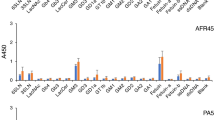Abstract
CD53 is an N-glycosylated pan-leucocyte antigen of 35–42 000 M r. The sequence of the CD53 polypeptide deduced from a cDNA clone is 219 amino acids in length. It appears to lack a conventional leader sequence because the deduced NH2-terminal amino acid sequence is very similar to the rat MRC OX-44 and human CD37 antigens. The CD53 molecule is likely to consist of four transmembrane regions and a major extracellular hydrophilic loop containing two potential N-glycosylation sites. It is suggested that the CD53 glycoprotein is the true human homologue of the rat OX-44 antigen, rather than the CD37 antigen of more restricted expression and lower NH2-terminal sequence similarity to OX-44.
Similar content being viewed by others
References
Bažil, V., Štefanová, I., Hilgert, I., Krištofová, H., Vaněk, S., Bukovský, A., and Hořejší, V.: Monoclonal antibodies against human leucocyte antigens. III. Antibodies against CD45R, CD6, CD44 and two newly described broadly expressed glycoproteins MEM-53 and MEM-102. Folia Biol (Praha) 35: 289–298, 1989
Bubien, J. K., Bell, P. D., Frizzell, R. A., and Tedder, T. F.: CD20 directly regulates transmembrane ion flux in B-lymphocytes. In W. Knapp, B. Dörken, W. R. Gilks, E. P. Rieber, R. E. Schmidt, H. Stein, and A. E. G. Kr. von dem Borne (eds.): Leucocyte Typing IV. White Cell Differentiation Antigens, pp. 51–54, Oxford University Press, Oxford, 1989
Classon, B. J., Williams, A. F., Willis, A. C., Seed, B., and Stamekovic, I.: The primary structure of the human leucocyte antigen CD37, a species homologue of the rat MRC OX-44 antigen. J Exp Med 169: 1498–1502, 1989
Dörken, B., Möller, P., Pezzutto, A., Schwartz-Albiez, R., and Moldenhauer, G.: B-cell antigens: CD37. In W. Knapp, B. Dörken, W. R. Gilks, E. P. Rieber, R. E. Schmidt, H. Stein, and A. E. G. Kr. von dem Borne (eds.): Leucocyte Typing IV. White Cell Differentiation Antigens, pp. 84–85, Oxford University Press, Oxford, 1989
Gottesman, M. and Pastan, I.: The multidrug transporter, a double-edged sword. J Biol Chem 263: 12163–12166, 1988
Hadam, M. R.: Cluster report: CD53. In W. Knapp, B. Dörken, W. R. Gilks, E. P. Rieber, R. E. Schmidt, H. Stein, and A. E. G. Kr. von dem Borne (eds.): Leucocyte Typing IV. White Cell Differentiation Antigens, pp. 674–678, Oxford University Press, Oxford, 1989
Hotta, H., Ross, A. H., Huebner, K., Isobe, M., Wendeborn, S., Chao, M. V., Ricciardi, R. P., Tsujimoto, Y., Croce, C. M., and Koprowski, H.: Molecular cloning and characterization of an antigen associated with early stages of melanoma tumor progression. Cancer Res 48: 2955–2962, 1988
Kyte, J. and Doolittle, R. F.: A simple method for displaying the hydropathic character of a protein. J Mol Biol 157: 105–132, 1982
Lipoldová, M., Boylston, A. W., Yssel, H., and Owen, M. J.: T-cell receptor Vβ5 usage defines reactivity to a human T-cell receptor monoclonal antibody. Immunogenetics 30: 162–168, 1989
Lux, S. E., John, K. M., Kopito, R. R., and Lodish, H. F.: Cloning and characterization of band 3, the human erythrocyte anion-ex change protein (AE1). Proc Natl Acad Sci USA 86: 9089–9093, 1989
Paterson, D. J., Green, J. R., Jefferies, W. A., Puklavec, M., and Williams, A. F.: The MRC OX-44 antigen marks a functionally relevant subset among rat thymocytes. J Exp Med 165: 1–13, 1987
Seed, B. and Aruffo, A.: Molecular cloning of the CD2 antigen, the T-cell erythrocyte receptor, by a rapid immunoselection procedure. Proc Natl Acad Sci USA 84: 3365–3369, 1987
Staden, R.: The current status and portability of our sequence handling software. Nucleic Acids Res 14: 217–231, 1986
Stamenkovic, I. and Seed, B.: Analysis of two cDNA clones encoding the B lymphocyte antigen CD20 (B1, Bp35), a type III integral membrane protein. J Exp Med 167: 1975–1980, 1988
Štefanová, I., Hilgert, I., Bažil, V., Angelisová, P., and Hořejší, V.: Reactivity of the Non-lineage/NK panel antibodies with purified antigens CD45, CD43, CD44, CD18, and three “novel” antigens MEM-43, MEM-53 and MEM-102. In W. Knapp, B. Dörken, W. R. Gilks, E. P. Rieber, R. E. Schmidt, H. Stein, and A. E. G. Kr. von dem Borne (eds.): Leucocyte Typing IV. White Cell Differentiation Antigens, pp. 678–680, Oxford University Press, Oxford, 1989a
Štefanová, I., Hilgert, I., Krištofová, H., Brown, R., Low, M. G., and Hořejší, V.: Characterization of a broadly expressed human leucocyte surface antigen MEM-43 anchored in membrane through phosphatidylinositol. Mol Immunol 26: 153–161, 1989b
Tamura, G. S., Dailey, M. O., Gallatin, W. M., McGrath, M. S., Weissman, I. L., and Pillemer, E. A.: Isolation of molecules recognized by monoclonal antibodies and antisera: the solid phase immunoisolation technique. Anal Biochem 136: 458–464, 1984
Author information
Authors and Affiliations
Additional information
The nucleotide sequence data reported in this paper have been submitted to the GenBank nucleotide sequence database and have been assigned the accession number M37033.
Offprint requests to: P. Angelisová.
Rights and permissions
About this article
Cite this article
Angelisová, P., Vlček, Č., Štefanová, I. et al. The human leucocyte surface antigen CD53 is a protein structurally similar to the CD37 and MRC OX-44 antigens. Immunogenetics 32, 281–285 (1990). https://doi.org/10.1007/BF00187099
Received:
Revised:
Issue Date:
DOI: https://doi.org/10.1007/BF00187099




